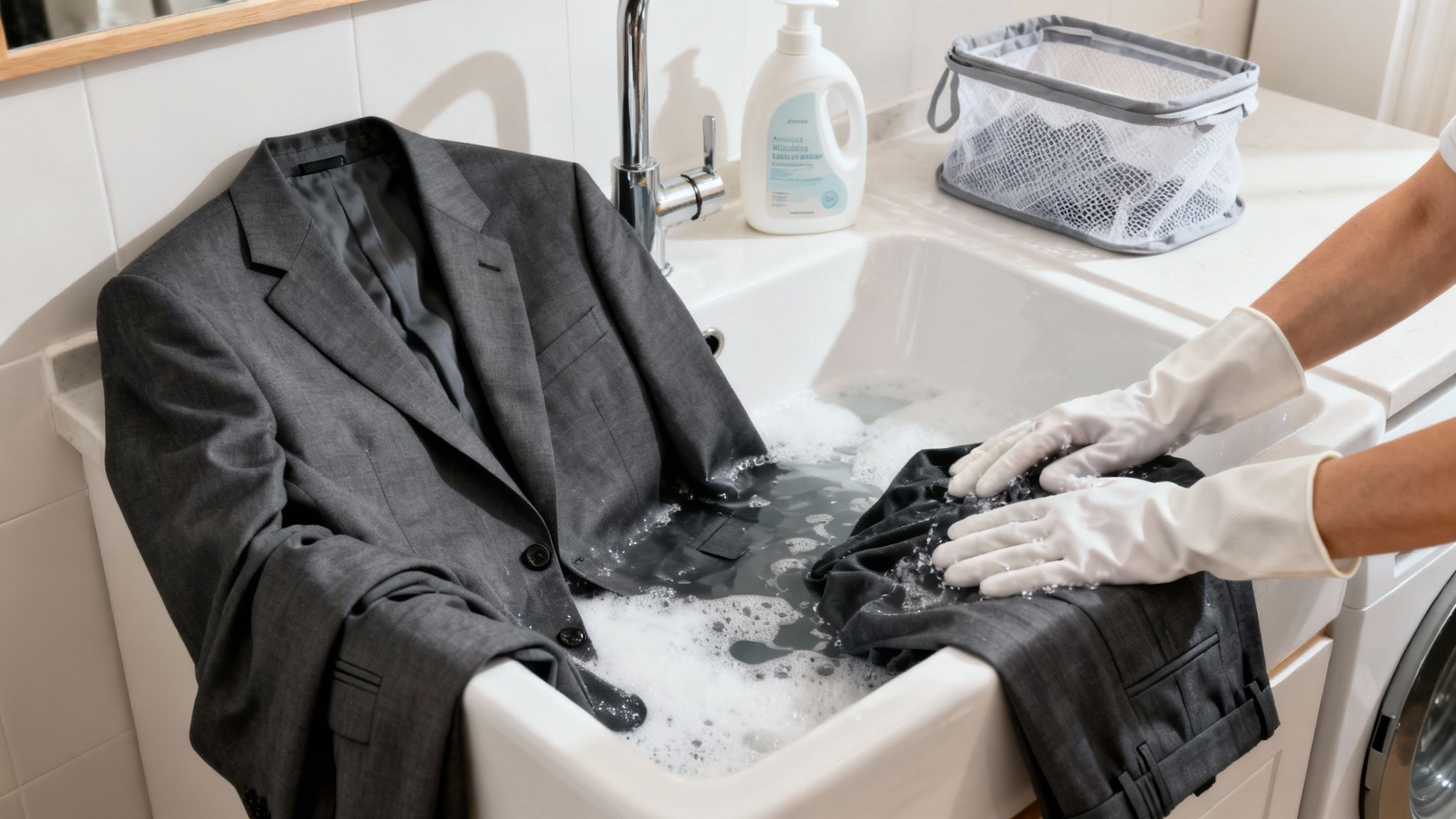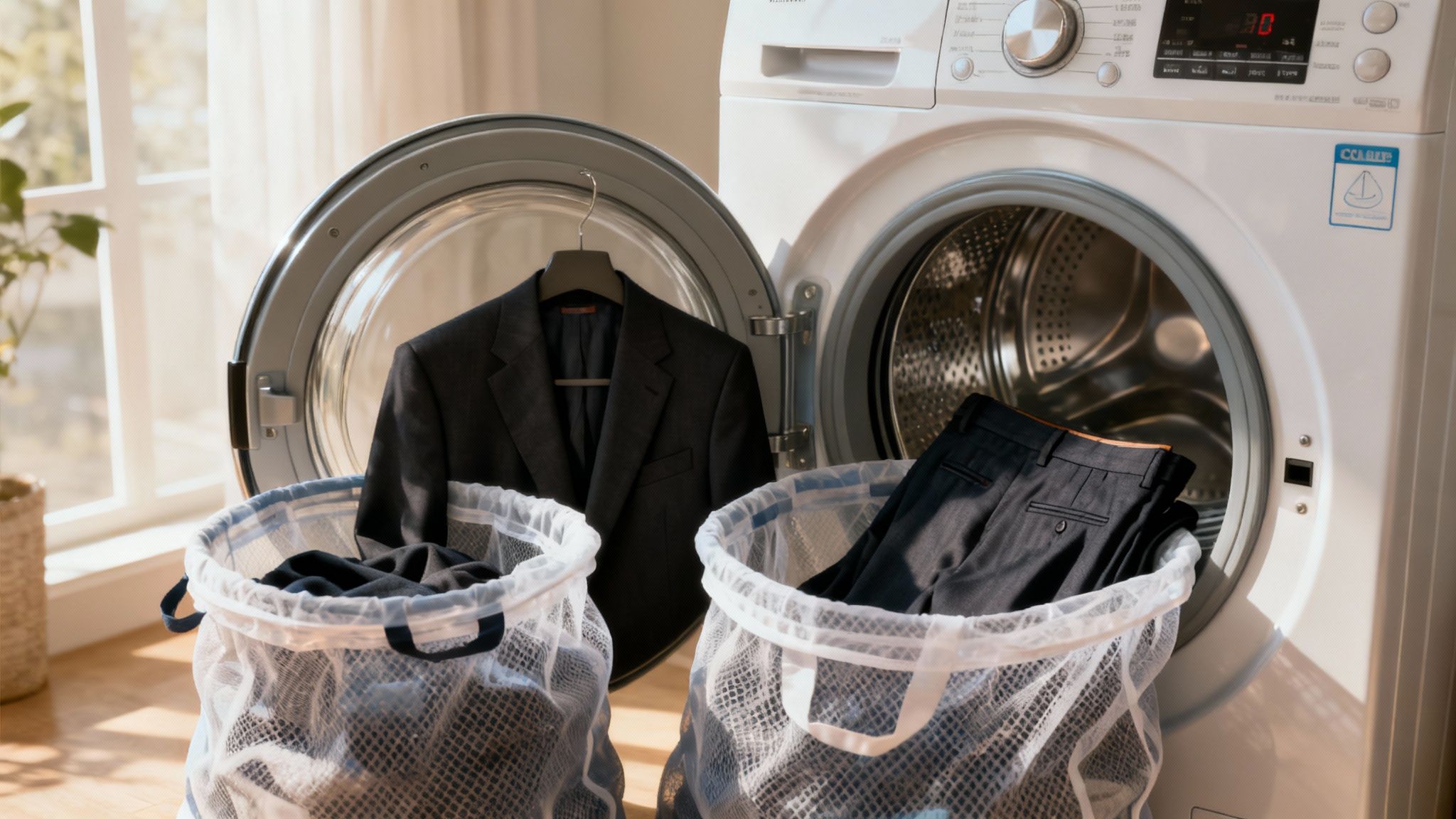How to Wash a Suit at Home: Easy Tips to Keep It Sharp

So, you're wondering if you can actually wash a suit at home. It’s a question that makes most people nervous, and honestly, for good reason. The short answer is yes, but it comes with some major caveats.
The real secret is knowing which suits can handle it and which ones need to be left to the pros. It all comes down to the fabric and how the suit is put together.
Is It Actually Safe to Wash a Suit at Home?
Tossing an expensive suit into the wash isn't something you do on a whim. For many high-end suits—especially those made of structured wool, silk, or velvet—the dry cleaner is non-negotiable. Trying to wash these at home is a recipe for disaster.
However, a lot of modern suits are made from more forgiving fabrics. If you have a suit made of cotton, linen, or certain polyester blends, you might be in luck. These can often be cleaned safely without a trip to the professionals.
Your first stop, always, is the care label. Think of that tiny tag as the manufacturer's direct orders for your suit.
If the label says "Dry Clean Only," believe it. This isn't just a friendly suggestion. It means the fabric, dye, or—more often than not—the internal structure of the suit will be permanently damaged by water. Ignoring it is a gamble that could leave you with a shrunken, warped, or discolored mess.
Suit Material Home Washing Suitability
To make things easier, here's a quick cheat sheet to help you figure out if your suit is a potential candidate for at-home washing.
Fabric TypeHome Washing FeasibilityRecommended MethodWool, Silk, VelvetNot RecommendedDry Clean OnlyCotton, LinenGood CandidateHand wash or delicate machine wash (cold)Polyester BlendsOften FeasibleCheck label; hand wash is safestRayon, ViscoseRiskyProne to shrinking; hand wash with extreme care or dry clean
This table is a great starting point, but always double-check your suit's specific care tag before making a final decision.
Understanding Your Suit's Construction
It’s not just about the fabric you see on the outside. A suit's internal structure is what gives it that sharp, tailored shape, and that's often the most vulnerable part.
Most suit jackets have hidden layers of canvas, padding, and interfacing. These are the components that create a crisp lapel and a structured shoulder. They are rarely designed to get soaked in water, and doing so can cause them to bubble, warp, or completely fall apart.
When to Go for It and When to Back Off
So, how do you make the final call? Run through this quick mental checklist before you even think about getting your suit wet.
- Feel the Fabric: Is it a more casual material like cotton, linen, or a simple polyester? If so, you can probably proceed, but with caution.
- Check the Structure: Does the jacket feel stiff and highly structured? Are the shoulder pads prominent? If it feels rigid, it's a risky candidate for a home wash. Unstructured or softly tailored blazers are always a safer bet.
- Trust the Label: Does the tag explicitly say "Dry Clean Only"? Take it seriously. A "Dry Clean" recommendation can sometimes be flexible, but "Dry Clean Only" is a hard and fast rule.
If your suit passes these three checks, you’re likely clear to move on to the washing stage. But if you have even the slightest doubt, remember this: the cost of professional dry cleaning is a tiny fraction of the cost of replacing a ruined suit.
If you're curious about what magic the professionals perform, you can learn more about how dry cleaning works in our detailed guide.
Prepping Your Suit for a Successful Wash

Honestly, whether your at-home suit wash is a roaring success or a total disaster is usually decided before a single drop of water is involved. Taking a few minutes to prep your suit properly can be the difference between a fresh, clean garment and one that’s been irreversibly damaged.
Think of it as a pre-flight checklist. You wouldn't skip it before takeoff, and you shouldn't skip it before washing something as structured as a suit. This little ritual is your best defense against the most common washing mishaps.
Conduct a Detailed Garment Inspection
First things first, lay your suit out somewhere with good lighting and give it a proper once-over. This isn't just a casual glance; you’re on the lookout for specific weak points that could become big problems in the wash.
Here's what I always check for:
- Loose Threads: Go over all the seams, buttonholes, and cuffs. A single loose thread can catch and unravel in the machine, causing some serious damage.
- Wobbly Buttons: Give every button on the jacket and trousers a gentle tug. If any feel even slightly loose, it's much better to reinforce them with a needle and thread now.
- Small Tears or Holes: Look closely for any tiny rips, especially near pockets or along the seams where there's more stress. A wash cycle will only make them bigger.
Next is a step you absolutely cannot skip: empty every single pocket. We've all heard those horror stories of an ink pen exploding mid-cycle or a forgotten lipstick melting into the fabric. Check every pocket—inside your jacket, on the trousers, everywhere. It's a simple habit that has saved more suits than you can imagine.
A forgotten tissue is one of the worst offenders. It will disintegrate and leave a blizzard of white flecks all over a dark suit, creating a mess that takes forever to clean up with a lint roller. A five-second check saves you an hour of tedious work.
The Art of Pre-Treating Stains
Okay, let's talk stains. If you've got a noticeable spot—maybe a drip of coffee on the lapel or a smudge on the cuff—you have to deal with it before the main wash. Hitting a stain with warm water is one of the quickest ways to set it for good.
For most common food or drink spills, a gentle spot treatment is all you need. Just mix a small drop of a mild, pH-neutral detergent with some cool water.
- Dip a clean, white cloth into your detergent solution.
- Gently blot the stain. Start from the outside of the spot and work your way in; this stops it from spreading.
- Whatever you do, don't scrub. Rubbing vigorously can fray the fabric fibers and push the stain deeper into the weave.
This careful blotting technique lifts the stain without roughing up the suit's fabric. By tackling these little things first, you're setting your suit up for a safe and effective cleaning, stopping small issues from turning into permanent headaches.
The Hand-Washing Method for Delicate Suits

If you've got a suit made from something a little more delicate, like wool or fine linen, hand-washing is your safest bet. It puts you in total control, letting you clean the garment gently without the rough-and-tumble of a machine. Think of it less like a chore and more like a spa day for your favorite suit.
The secret to getting this right is patience and a light touch. Any aggressive scrubbing or twisting can stretch out the fibers and completely ruin the suit’s tailored shape. Your goal here is simply to lift out dirt and oils, not to manhandle the fabric.
Preparing the Washing Space
First things first, make sure your bathtub or a large basin is spotless. You'd be surprised how easily leftover soap scum or cleaning residue can transfer onto the fabric. A quick wipe-down and rinse are all it takes.
Now, fill the tub with cool to lukewarm water—and never hot. Hot water is the number one enemy of natural fibers like wool and a surefire way to shrink your suit. You only need enough water to completely cover the suit, usually about 4 to 6 inches deep. Add just a small amount of a pH-neutral, wool-safe detergent, and swish it around to create a gentle, sudsy bath.
Pro Tip: Whatever you do, don't pour detergent directly onto the dry suit. Always mix it into the water first to avoid concentrated spots that can cause discoloration or damage the fibers.
Once your water is prepped, you can gently place the suit in. For more specific advice on different types of jackets, our guide on how to clean a blazer has some great detailed instructions.
The Gentle Soaking and Rinsing Process
Gently press the jacket and trousers down into the water until they're fully submerged and saturated. Now, just let the suit soak for about 20-30 minutes. Every so often, you can gently press down on different parts of the suit with your palms. This small motion is all you need to work the water through the fabric and dislodge any grime.
After the soak, drain the soapy water. To get the excess moisture out, do not wring or twist the suit. This is critical. Instead, gently ball up the garment and press it against the side of the tub to squeeze out the suds.
Refill the tub with clean, cool water for the rinse. Gently swish the suit around to work out any remaining detergent. You’ll likely need to drain and repeat this a couple of times until the water runs completely clear. A thorough rinse is key because any leftover soap can leave the fabric feeling stiff and actually attract more dirt later on.
While knowing how to hand-wash is a fantastic skill, it's good to know the trade-offs. Professional services, which typically run between $10 and $20 per suit, use specialized solvents and expert pressing techniques that really can extend a garment's life.
Using Your Washing Machine Without Fear

I get it—the thought of putting a suit in a washing machine sounds terrifying. But for those durable cotton, linen, or polyester suits, your machine can absolutely be your ally, if you treat it with a bit of respect.
The goal here is to transform this powerful appliance into a gentle cleaning tool, not a fabric-shredding monster. Forget everything you know about your typical laundry load; this is a completely different ballgame that requires precision and care.
First thing's first: containment. You need to place the suit jacket and trousers into separate, large mesh laundry bags. This isn't just a friendly suggestion; it's a must-do. These bags create a protective barrier, stopping the sleeves from getting twisted into a knot or a button from snagging on the drum. It’s the single most important step you can take to prevent a disaster.
Dialing In the Perfect Settings
Once your suit is safely bagged up, it's time to talk to your machine. You're basically trying to mimic the gentle swishing of a hand-wash, and modern washers make this pretty easy if you know what buttons to push.
- Cycle Selection: Go for the most delicate cycle you've got. It's usually labeled 'Delicates,' 'Hand Wash,' or 'Wool.' These settings are designed with minimal agitation and slow, gentle spinning to keep fragile clothes in one piece.
- Water Temperature: This one’s easy: cold water only. Anything warmer can cause the fabric to shrink, fade, or lose its shape, which is a real nightmare for the structured shoulders and lapels of a jacket.
- Spin Speed: Crank that spin speed down to the lowest possible setting. A fast spin cycle will wring the life out of your suit, setting in deep wrinkles and putting a ton of stress on the seams.
Think of it like parking a car in a really tight spot—you have to go slow and steady. Rushing it or hitting the wrong setting can do irreversible damage to your suit's fit.
Choosing the Right Detergent
What you wash with is just as important as how you wash it. A harsh, powdered detergent is a big no-no; it can leave behind a chalky residue and be too abrasive on the fabric's fibers.
Instead, reach for a gentle, liquid detergent. I always recommend one specifically made for delicates or woolens.
The real trick? Use just a tiny amount. Seriously, about a tablespoon is usually plenty. Overdoing it on the soap creates a mountain of suds that are tough to rinse out completely. That leftover residue can make the fabric feel stiff and, ironically, attract more dirt later on.
By sticking to these steps—bagging the suit, choosing the gentlest cycle, using cold water, and picking the right detergent—you can turn a risky chore into a totally manageable part of your garment care routine.
How to Dry and Finish Your Suit Perfectly

Getting the final steps right is arguably the most critical part of washing a suit at home. This is the make-or-break moment where you restore the garment’s shape, texture, and professional finish. If you rush this part, all that careful washing you just did could be for nothing.
Let's start with a hard-and-fast rule: the machine dryer is the absolute enemy of your suit. The intense heat can shrink natural fibers, literally melt synthetic ones, and permanently warp the internal structure—think shoulder pads and interfacing. Even the "low-heat" setting is just too big of a risk to take.
Of course, for your everyday laundry, a working dryer is a must. It's always a good idea to troubleshoot a dryer that's not heating as soon as you notice a problem. But for your suit? We're sticking to good old-fashioned air.
The Art of Air-Drying a Suit
Proper air-drying is all about working with gravity, not against it. The idea is to let the suit hang naturally, allowing its own weight to gently pull out creases while it settles back into its tailored form.
For the jacket, the hanger you choose is crucial. A flimsy wire hanger will dig into the fabric, creating nasty puckers and completely ruining the shoulder line. You need a wide, wooden, or padded hanger that actually mimics the shape of your shoulders. This provides the support it needs to prevent stretching and distortion while it's heavy with water.
When it comes to the trousers, hang them from the cuffs or hem using a clamp-style hanger. I know it seems backward, but hanging them upside down uses the weight of the waistband to gently straighten the fabric, which helps minimize wrinkles without you having to do a thing.
Find a spot with good ventilation, but keep the suit away from direct sunlight or any intense heat source. A hallway with a cross-breeze or a spare room with a fan running on low is perfect. Direct sun will fade the fabric, and a nearby radiator can cause uneven drying and shrinkage.
Even if you're working with limited space, you can make this work. There's some great advice on how to air dry clothes indoors that's just as useful for a suit as it is for your shirts.
Perfecting the Final Finish
Be patient here—your suit needs to be completely dry, which could take anywhere from 24 to 48 hours. Once it is, it's time for those finishing touches that separate an amateur job from a professional one.
First, go after any stubborn wrinkles with a garment steamer. An iron is way too harsh and can create that permanent, ugly shine on the fabric, which is especially noticeable on darker suits. Just hold the steamer a few inches from the fabric and use gentle, sweeping motions. The steam relaxes the fibers and releases creases without any damaging, direct heat.
Finally, give the entire suit a once-over with a soft-bristled clothes brush. Brushing in a downward motion lifts the nap of the fabric, restoring its natural texture and sheen. This small step also whisks away any lint or dust that might have settled while it was drying, leaving your suit looking crisp, refreshed, and ready to wear.
Drying and Finishing Checklist
Here's a quick rundown to make sure you nail the final, crucial stages of caring for your suit at home.
StepAction RequiredKey Tip1. Choose HangersUse a wide, shaped hanger for the jacket and a clamp hanger for the trousers.This prevents shoulder puckers and uses the trousers' weight to reduce wrinkles.2. Select LocationHang the suit in a well-ventilated area away from direct sun or heat.Good airflow speeds up drying; avoiding heat prevents damage and fading.3. Be PatientAllow 24-48 hours for the suit to dry completely.Rushing this step can lead to musty smells or damage during finishing.4. Steam, Don't IronUse a garment steamer to gently remove any remaining wrinkles.An iron can create a permanent shine and damage the fabric's fibers.5. Brush It OffFinish with a soft-bristled clothes brush to restore texture and remove lint.Brush in a downward motion to lift the fabric's nap for a polished look.
Following these steps will ensure your suit not only gets clean but also maintains the sharp, tailored look you invested in.
Common Questions About Washing Suits at Home
Even with the best instructions, taking the plunge to wash your own suit can feel a little nerve-wracking. That’s totally normal. A few questions always pop up, and getting them answered is the key to building the confidence you need for a great result.
Let’s clear up some of the most common worries I hear.
How Often Should I Really Wash My Suit?
This is a big one, and the most common mistake is actually over-cleaning. You should only give a suit a full wash when it's visibly stained or has a stubborn odor that just won't air out. Washing it too often puts a ton of stress on the fabric and the suit's internal structure, causing it to wear out much faster.
After you wear it, just hang your suit outside the closet for a few hours to let it breathe. A quick once-over with a soft clothes brush to get rid of any dust or lint is usually all the maintenance it needs. Honestly, for most guys, a full-on wash is something you’ll only need to do once or twice a year, tops.
Think of it this way: the less you wash your suit, the longer it’s going to last. A full wash is a major intervention, not routine care. Your best friends for keeping a suit fresh are airing it out and spot-treating.
Can I Wash Just the Jacket or the Pants?
I get why people ask this—it seems like a practical shortcut if only one piece got dirty. But the answer is a hard no. You absolutely must always wash both pieces together.
Every time a garment goes through a wash cycle, no matter how gentle, it causes tiny, almost invisible changes to the color and texture. If you start washing the jacket more than the pants (or the other way around), they'll begin to fade and wear at different rates. Before you know it, you'll have a noticeable mismatch, and your suit will look more like two separate, slightly different-colored pieces.
What If the Tag Says Dry Clean Only?
When you see a "Dry Clean Only" label, treat it as a non-negotiable rule. That tag is the manufacturer's way of telling you that the materials, dyes, or internal construction are simply not built to handle water.
Trying to wash these suits at home is a gamble with very high stakes. You're risking:
- Shrinking: Wool and other delicate materials can shrink up in a heartbeat when they hit the water.
- Warping: The delicate canvas and shoulder pads that give the jacket its shape can get completely distorted.
- Color Bleeding: The dyes might not be water-safe, leading to a splotchy, faded mess.
For these specific suits, a professional dry cleaner is the only way to go. It's about protecting your investment. And beyond just washing, learning more about general suit care is key. To get more great advice on making your suit last, check out these essential suit care and maintenance tips.
Are Home Dry Cleaning Kits a Good Alternative?
Home dry cleaning kits have their place, but it's more for refreshing a suit, not truly cleaning it. These kits usually come with a chemical-treated cloth that you toss in the dryer with your suit. The heat creates steam that helps deodorize the fabric and shake out some light wrinkles.
They work pretty well for getting rid of that "worn-once" smell or a few creases between professional cleanings. But when it comes to actual dirt, body oils, or set-in stains? They won't make a dent. Think of them as a quick touch-up tool, not a replacement for a proper wash when your suit is genuinely dirty.
When in doubt, it’s always better to trust the experts. At Columbia Pike Laundry, we handle everything from delicate suits to everyday wear with professional care. Schedule a pickup and let us give your garments the attention they deserve, so you can focus on what matters most. Learn more about our services and reclaim your time.
Popular Blog Articles

Meet the Author
Daniel Logan didn’t start CPL because he loved laundry. He started it because his family was drowning in time debt, and laundry was one of the biggest weights.
Mornings were chaos with two kids under 5. Evenings felt like catch-up. And weekends? Gone to sorting socks and folding piles.
He knew his story wasn’t unique. So he built a business that gave families like his just a little bit of breathing room one load at a time.
With no laundry experience but deep tech skills, Daniel rolled up his sleeves, doing every job himself while building systems that turned it into a modern laundry service that saves customers time, simplifies their lives, and delivers reliability they can count on.
That’s where CPL began. Not from a playbook, but from pain. From one dad trying to buy back time: for himself, and for every household like his.





